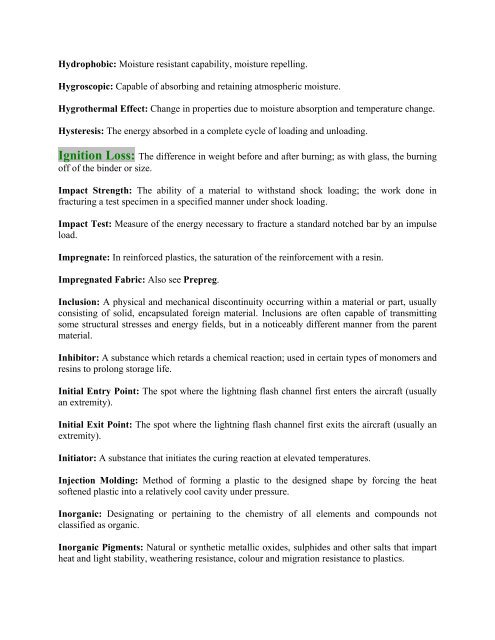Definitions /Dictionary/Glossary - nptel
Definitions /Dictionary/Glossary - nptel
Definitions /Dictionary/Glossary - nptel
You also want an ePaper? Increase the reach of your titles
YUMPU automatically turns print PDFs into web optimized ePapers that Google loves.
Hydrophobic: Moisture resistant capability, moisture repelling.<br />
Hygroscopic: Capable of absorbing and retaining atmospheric moisture.<br />
Hygrothermal Effect: Change in properties due to moisture absorption and temperature change.<br />
Hysteresis: The energy absorbed in a complete cycle of loading and unloading.<br />
Ignition Loss: The difference in weight before and after burning; as with glass, the burning<br />
off of the binder or size.<br />
Impact Strength: The ability of a material to withstand shock loading; the work done in<br />
fracturing a test specimen in a specified manner under shock loading.<br />
Impact Test: Measure of the energy necessary to fracture a standard notched bar by an impulse<br />
load.<br />
Impregnate: In reinforced plastics, the saturation of the reinforcement with a resin.<br />
Impregnated Fabric: Also see Prepreg.<br />
Inclusion: A physical and mechanical discontinuity occurring within a material or part, usually<br />
consisting of solid, encapsulated foreign material. Inclusions are often capable of transmitting<br />
some structural stresses and energy fields, but in a noticeably different manner from the parent<br />
material.<br />
Inhibitor: A substance which retards a chemical reaction; used in certain types of monomers and<br />
resins to prolong storage life.<br />
Initial Entry Point: The spot where the lightning flash channel first enters the aircraft (usually<br />
an extremity).<br />
Initial Exit Point: The spot where the lightning flash channel first exits the aircraft (usually an<br />
extremity).<br />
Initiator: A substance that initiates the curing reaction at elevated temperatures.<br />
Injection Molding: Method of forming a plastic to the designed shape by forcing the heat<br />
softened plastic into a relatively cool cavity under pressure.<br />
Inorganic: Designating or pertaining to the chemistry of all elements and compounds not<br />
classified as organic.<br />
Inorganic Pigments: Natural or synthetic metallic oxides, sulphides and other salts that impart<br />
heat and light stability, weathering resistance, colour and migration resistance to plastics.
















